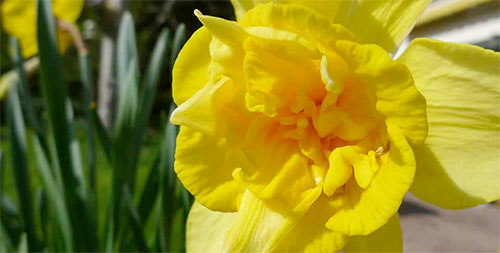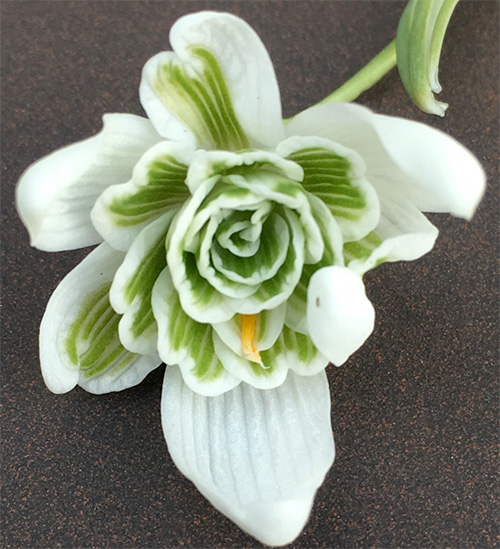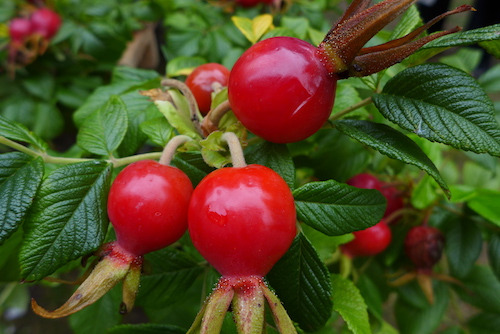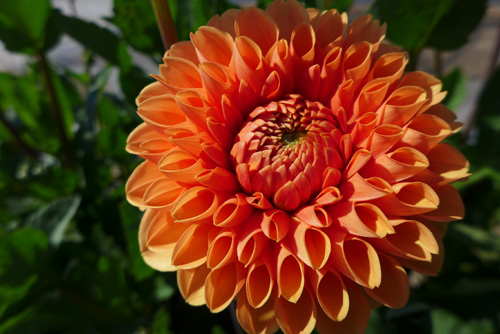
An enthusiastic, self-taught gardener, Tara Lissner is passionate about gardening and eager to share her zeal and knowledge with other gardening fans.
In 2012, she joined forces with Hester Macdonald, a British-trained landscape designer, to launch the Swiss Gardening School.
(Photo by Jean-Luc Pasquier)
Swiss Gardening School
www.swissgardeningschool.com

By Tara Lissner, Swiss Gardening School
With the garden centres and DIY shops heaving with beautiful summer annual flowers, salad plug plants and vegetable plants it is understandable that you could be fooled into thinking that it is time to plant up the garden. But no, as the weather over the past few days has confirmed there is still time for snow and late frosts. When temperatures drop overnight to around zero significant damage may be done to immature and tender plants. Local advice dictates that nothing tender should be planted outside unprotected until after the days of the “ice saints”. These ice saints, Saint Mamertus, Saint Pancras and Saint Servatius, celebrate their feast days on 11, 12 and 13 May each year. Each year of course differs from the last and often temperatures are accommodating and we have no issues with chilly nights but when we do we really do. With temperatures due to stay low cover your veggie beds with horticultural fleece and move your pots next to the house for a little protection.
I am frequently asked what do with bulbs when the flowering has finished. Firstly and most importantly enjoy the flowers, whether you leave them in the garden or cut them for the house. The next tip is to dead head all the daffodils, only trim the flowering stem, this prevents the plant from producing seed. Allow the leaves to turn yellow, and I’m afraid this is where patience is necessary, the longer you wait the greater the show next year. When the leaves are limp and yellowed only then it is time to cut them back. Daffodils do very well when left in beds or naturalized in the lawn, tulips are a little more temperamental. In public spaces the tulips are always dug up, and new ones planted later in the year, this is not terribly practical or economic in a private garden. To get the best repeat show with tulips make sure they are well planted by December, three times the depth of the bulb, make a note in your garden notebook as to where they are (you will forget); there is nothing worse than digging up bulbs inadvertently when they are dormant in order to plant something else. Ensure the area does not dry out over the summer and don’t forget to fertilize the space with a general purpose fertilizer later in the year when all signs of the tulips have disappeared.

By Tara Lissner, Swiss Gardening School
I do so love a snowdrop! One of the very first signs that the depths of winter are behind us. Their delicate hanging flowers suspended from a tiny stem piercing the earth with the message that spring is on the way. Although we have been rather spoiled this year with a mild winter season it is still rather nice to see the changes in the garden. With bulbs forcing their way through the soil and shoots appearing on everything from roses to forsythia – it is time to get ready to get back to work.
I have found it to be quite challenging to find interesting Snowdrop bulbs here, most garden centres sell the traditional Galanthus nivalis, common snowdrop. I am always on the look out for something a little more special like the Galanthus nivalis ‘Flore Pleno’ pictured above. If you are lucky enough to have some in your garden, and your drift is looking a little cramped, now is the time to split them. Snowdrops do not like to dry out whether in bulb form or in the green (the term used for the way snowdrops are dug up for planting once the flowers have gone over) so be quick. By digging up a dense clump, gently teasing the bulbs apart and replanting the new smaller clumps you will increase your display. When replanting make sure you add a few handfuls of fresh new soil to the hole and water them in well. As they are one of the first bulbs to show up it is important that they are planted where they can be easily enjoyed, next to a front door, or along a hedge to a gate. Splitting them like this encourages the growth of tiny new offsets thus bulking up the new clump. There has been quite the renaissance in interest in these tiny bulbs, a new world record was set in February 2015 for GBP 1390 for a single bulb Galanthus placates ‘Golden Fleece’ – it took 10 years to breed and another eight to produce enough to sell! If you are interested in more out of the ordinary snowdrops take a look at this website run by the galanthophile Joe Sharman from Cambridgeshire, I may have to order some bulbs later this year.

By Tara Lissner, Swiss Gardening School
With another year coming to a close it is time to thing about wrapping things up in the garden.
Tender plants need to be moved to sheltered spots if possible, covered in horticultural fleece whether they be in the ground or in pots. Pots should be raised a couple of cms from the ground to allow for free drainage, pots left to sit on the terrace may freeze and eventually crack, this is particularly the case with terracotta which over time disintegrates into shards. While the weather remains mild why not take a closer look at your flower beds and borders, neaten them up by trimming back the old growth and add a 5cm mulch of leaf mould, garden compost or bagged mulch compost from the garden centre. Mulching at this time of year provides a number of benefits; it acts as a slow release fertilizer, as it is dragged down by worms it also helps improve the structure of the soil and finally this dressing neatens up the overall look of the bed a plus at this time of the year when the garden can look a little bedraggled.

By Tara Lissner, Swiss Gardening School
What a lovely October we’ve had and what a start to November, bright blue skies and sunny afternoons, gorgeous leaf colour developing every day. With the change in time and ever reducing light levels winter will soon be upon us. Given how many Christmas displays and markets are popping up all over we have to face the fact that the festive season will soon be upon us and this means most of the work in the garden this year is coming to an end.
There is still lots to keep busy with however, a pair of wellies, warm socks and a few layers should be enough to keep out the cold and the occasional sunny day will keep us smiling as we prepare for the winter. At my local compost heap this morning I was astounded by the huge number and variety of leaves dumped into the massive containers to be taken away to the great big composting heaven in Givrins. Leaves, and a little patience, will give us the greatest free compost imaginable - leaf mould. Rake up the fallen leaves from your garden, or mow them up with the lawn mower if you have masses, pile them into large black plastic sacks, tie the bags and puncture them all over with holes. Hide them behind the garage, the shed or next to the compost heap anywhere they might get a little wet from the rain and just wait. If kept nicely damp in six months you'll have your own mulch and in a year leave compost, perfect to return to your own garden.

By Tara Lissner, Swiss Gardening School
What a wonderful September we’ve been enjoying. The summer heat may be long gone but gentle temperatures, sunshine and just a touch of rain are spoiling us. The soft September light sets off the brilliant colours of autumn; the orange, yellow and red of flowers, leaves and fruit – a beautiful time, a wonderful season. This time of year allows us to consider where we succeeded and where we need to concentrate our efforts while allowing us to get things into shape before the cold and dark days arrive. I’ve been working on a large plot, removing very old large growth, weeding a lot, turing the soil with the aid of a man with a digger, raking over again and again and finally covering the space with geotextile. Now all I have to do is make a plan for planting. Planning improves our chances of success. Take a close look at your garden and your vegetable garden, what worked, what failed, what did you really enjoy eating and what got left behind – each question has an answer and each answer allows for a change. Photographs also help with planning, take many and remind yourselves later in the year what you loved and what you can do without – make the change, easier said than done I realize but it is important to start.
At this time of year there is so much to do, in fact at almost every time of year there is so much to do. This is the time of that mad dash to get the garden ready for winter before you no longer want to step outside. Tidy up the flower beds, deadhead the blooms that have gone over, allowing energy to be directed to the remaining buds; keep on top of the weeding as weeds continue to grow well; lawn care and repair should be high on the to do list after our scorching summer. Plan some time to buy some bulbs, already now I hear you but yes already now. All local garden centres, DIY shops and even supermarkets carry a vast selection of bulbs. The best choice and the best quality is available now, don’t delay. They may be planted in borders, in the lawn or in pots and will give you tremendous joy in the spring when plants, trees and shrubs are dormant.









